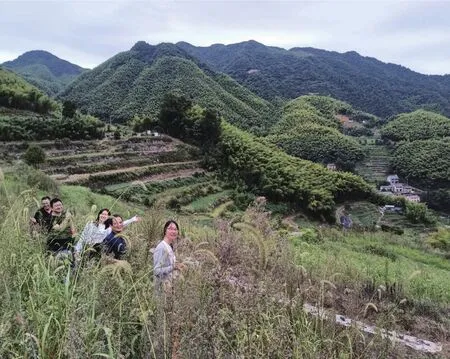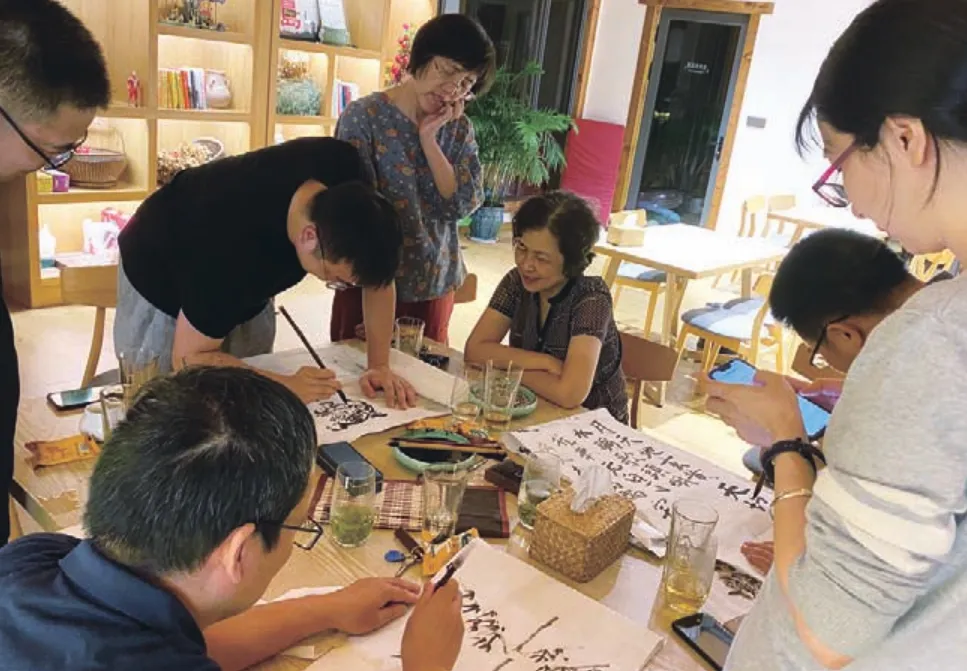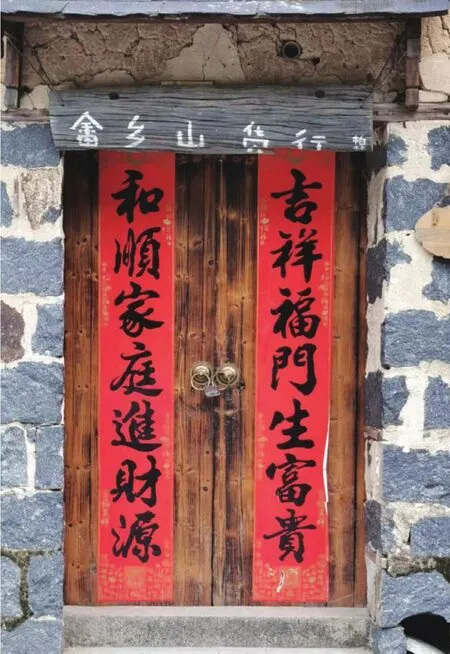山乡物语
2023-01-31文/陈野
文 /陈 野

作者团队在浙江乡野群山中。Enjoying country life in Zhejiang.
一
初冬某日,由杭州去往德清。一路行去,见平畴清远,山峦层叠,林木错落,村舍散布。饱游沃览的,正是东晋王子敬“山川自相映发,使人应接不暇。若秋冬之际,尤难为怀”的光景。几经曲径幽转,进入一片连绵低山围合出的谷地,于道路尽头开启一道竹扉,迎面而来的是一座山园。园内有小筑数重,果树漫坡,畦田齐整,花木扶疏。杉树干挺叶密,拉起通透的绛色纱帐;冬日暖阳映照万物,斑驳陆离的光线在空气里闪烁,银杏灿烂,竹林、桂树暗影深重。及至斜阳西下,霞光与山色交融,顷刻变幻,紫绿万状。

民宿外的绿叶黄墙。Green leaves and yellow walls outside a B&B hotel.

先锋书店的书墙。The book wall at Librairie Avant-Garde.
城里来的先生于园中开设一座书房,随机做一些习史读书的直播活动。既是工作之余的休憩之所,也是有心致力的文化传播平台。我们此行,便是与几位来自北京、杭州的学者,在书房里举办以《疏影》《暗香》为创作题材的诗词书画赏鉴直播。话语之间,园里自养的边牧大犬悠然而来,径直卧于直播台下,听着讲解安然入眠;屋外有闲散鸡群,于红、黄、绿叶夹杂的乌桕树下四处觅食。此景此境,与陶渊明笔下的桃花源十分贴合:“土地平旷,屋舍俨然,有良田、美池、桑竹之属。阡陌交通,鸡犬相闻。”
今年仲秋,我们乡村研究课题组一行回访了曾经驻村深度调研五年的桐庐龙峰民族村。在村里的畲族文化馆内,村民和村干部们正在为央视即将来此拍摄的纪录片做准备。所到之处,熟悉的痕迹历历在目,唤起亲切忆念,重逢的欢快在滔滔不绝的晤谈中流泻。村里八十五岁高龄的雷依香老人,是畲歌传承人、金牌推介人。课题组老师循着她外出购物的步履,在村道上寻到了身板硬朗、爽朗健谈的老太太,与她作出记录畲歌和创作畲族文化主题绘画的约定。
到达同为畲族村落的戴家山新丰村时已近黄昏,暮霭渐起。我们在山间漫游,于村中流连。青灰色的远山层层叠叠,蜿蜒铺展而去,盛放着无限丰富的自然细节。近山茏翠,林长草丰,有青竹、枫香、玉兰、红豆杉高耸挺立,浓荫铺地。山道坡沿,各种作物自由生长。客舍边的枣树,绿叶红果映衬着黄泥土墙,古雅明丽。循着潺潺之声而去,但见清冽溪涧、竹篱小桥、嶙峋山石,上有农家民宿餐厅,恰似南宋画卷中边角之景的高台水榭。以“大地上的异乡者”为标识的云夕图书馆,书墙林立,足以让人细细检视,精挑细选,体会迥异于网上购书的书页摩指之感。
颇具声名的戴家山 · 8号民宿位于溪涧两侧,与时下的精品民宿一样,设施、用品与布置的完备、整洁、时尚自不待言。令人欣喜的是它视野深远、风格现代、任由住客自在使用的顶层活动室,以及那宛如碧玺般嵌于山地里的清澈泳池。
晚餐后,“篱落疏疏水依轩,小窗明烛透轻绡”。我们在活动室围坐夜叙,喝茶聊天,挥毫画虎,水墨写竹,赋诗题词。吟诵之间,《兰亭集序》《陋室铭》《归去来兮辞》等名篇,都化作了笔下的书迹。
二
这些年,我们在乡村大地上走街串巷,从东部海岛到西部田园,从浙南山区到浙北平原,于山野间见翠色连绵、林泉洄环,在田间地头看青禾浓绿、稻浪翻飞,在深街浅巷观游人如织、村颜新貌;也曾品味过黛瓦白墙里老旧衰颓的岁月留痕,感悟于老人黄昏独坐的人生孤寂,忧心于传统手艺的后继乏人。林林总总,在在如是,近距离感受着乡村的时代变迁与印迹,观察、品味、思考着我们这个时代的乡村形态和特征。
与自然山水紧密相连的乡村世界,辽阔、丰盈、包容,是舒缓紧张城市生活节奏的桃源之所。那些清风明月的山岗,那些兀自欢唱的流水,那些平远无垠的原野,那些古意盎然的村落,那些繁茂丰盛的田园,凝山川之气,聚草木之趣,生动灵性。现代人于此尽享“偷得浮生半日闲”的闲适,也在时时刻刻的美的发现和心灵触动中,获得任意自由想象、激发创意灵感的活力渊薮。
乡村的生活,透着人世间的本真。戴家山上的乡居生活,是勤勉不息的耕种劳作,殷勤待客的淳朴情意,新鲜的高山蔬菜,醇厚的红曲酒,遇人不惊、遇车不让的犬,与客对视、若有所思的猫,春联与灯笼织就的喜庆与祈福,处处都是陆游《游山西村》中“莫笑农家腊酒浑,丰年留客足鸡豚。山重水复疑无路,柳暗花明又一村。箫鼓追随春社近,衣冠简朴古风存。从今若许闲乘月,拄杖无时夜叩门”的现实写照。
朴实安稳的日常,是于历史中时隐时现、在理想中不懈追寻的美好。其间的亲切温润来自家园故土的博爱,在“行行重行行”的人生旅程中,予人此枝可栖的依恋。
生发、沉潜、绵延于乡村的文化传统,为历代文人提供着精神寄寓的原乡。在他们于穷达、进退、隐显间的穿梭往来中,乡村永远在场。我们在这山里乡村所得的欢喜,便是南宋罗大经《山静日长》情景的印证和亲享 :“苍藓盈阶,落花满径,门无剥啄,松影参差,禽声上下……随意读《周易》《国风》《左氏传》《离骚》《太史公书》及陶杜诗、韩苏文数篇。从容步山径,抚松竹,与麛犊共偃息于长林丰草间。坐弄流泉,漱齿濯足……弄笔窗间,随大小作数十字,展所藏法帖、墨迹、画卷纵观之。”如此的深情与意趣,让卷轴简册与山色乡情交相辉映,建构起意蕴深浓的精神传统,涵育着人们热爱和追随文脉的天然基因,造就了人文田园绵密醇厚的不朽经典。

作者参加雅集活动。The author attends a cultural gathering.
德清的半坡书房和文化直播,龙峰村的畲族文化馆和央视纪录片,戴家山的精品民宿与云夕图书馆,都是城市人群和当代生活方式走进乡村的足迹,以其关注、参与和创造回应乡土呼唤,致力于改善乡村人居环境,提供新的经济发展业态,将现代文明的观念、时尚和品质融入乡村生活,陶炼、提升着乡村的当代气质和整体风貌。
如上种种,呈现出当下乡村形态中风云际会、光被雨润的多重“会通”。半坡书房的直播活动,举办于充满人文气息的空间,而书房则坐落于优美的自然山川之间,这是人文与自然的会通;直播活动的参与者、我们课题组以及央视纪录片的拍摄者,都是来自都市的 “城里人”,而活动于乡村环境,这是城市与乡村的会通 ;活动内容中的《疏影》《暗香》、诗词吟诵、经典解读,有众多古典生活的元素和意趣,它们不但得到传承,而且还有内容、形式和传播手段上的创新,表现出宛如春水般碧波荡漾的活化形态,这是传统与现实的会通;乡村文明经过现代文明的陶炼和融入,获得时尚化的品质,这是乡土与时尚的会通。
乡村中也有不如人意的发展短板和不容忽视的种种问题,但更形成了立足于当代经济社会形态,融合自然、古典、时尚、现代等要素的整体发展风貌,体现了乡村发展的历史际遇、内在逻辑和文明进程。
三
中国乡村的现代化进程,与一个东方大国的现代化追求相伴随,步履艰难而又波澜壮阔。其意蕴之丰沛,与中国生活、中国社会和中国文化深切相连。回溯中国乡村自中国社会开启现代转型以来走过的兴衰起伏之命运轨迹,可谓千回百转、曲折萦纡。数辈乡民身居不同时代,应对多重挑战,以吃苦耐劳、隐忍柔韧、顽强进取的品格精神,维系了村庄命脉和厚重历史。
然而,由古至今,乡村也是最缺乏历史记载和文献档案系统、最难见到其在历史进程中完整形影的场所。即使在今天的文化场域中,相比于文化人众声鼎沸、各自张扬的景象,乡村以及乡民并未完全获得他们应有的文化话语地位。所以,在享受乡村生活的同时,在为乡村奉献的同时,我们更要为乡村发声。
Tales from the Countryside
By Chen Ye

田园风光。Pastoral life.
On an early winter day, we set off to Deqing county, Huzhou from Hangzhou. I was impressed with the expansive farmland,mountain ranges and woods on my way there. After a few winding paths and turns, we entered a valley surrounded by low hills and saw at the end of the road a bamboo gate open into a mountain garden.
Inside the garden, there were several small buildings, fruit trees all over the slope, neatly arranged ridge-bordered plots, and sparse flowers and trees. The upright cedar trees had very dense crowns, and a transparent crimson tent was drawn up. The warm winter sun caressed everything, its diffusive rays shimmering in the air. Under the sunlight, the ginkgoes looked bright and sparkling while the bamboo forest and the laurel trees appeared dark and shadowed. When the sun sunk in the west, the color of the haze and mountain began to mix, changing instantly from purple to green and many other hues.
There was also a study set up by an urban gentleman for doing cultural-themed live streaming events. It was both an after-hour resting place and a cultural communication platform. Our purpose for this trip was to put up such a live show on appreciating poetry,calligraphy and painting with several scholars from Beijing and Hangzhou.
In mid-autumn this year, our rural research group revisited the Longfeng ethnic village in Hangzhou’s Tonglu county, where we spent five years doing in-depth field research. In the village’s culture hall, the ethnic She villagers and village officials were preparing for a China Central Television documentary to be shot here.
Everywhere we went, we saw familiar traces that evoked our memories, and were thus overwhelmed with the affection and joy of reunion. Conversing with villagers cheerfully, we found out an 85-year-old lady named Lei Yixiang was an inheritor and gold medal ambassador of She songs. A teacher from our group followed her footsteps as she went out shopping, and made an appointment with this talkative old lady to record some She songs and create some paintings on the theme of She culture.
When we arrived at the Xinfeng village in Daijia Mountain,another She village, it was almost dusk and the evening mist was rising. We roamed through the mountains and lingered in the village. The green and gray hills from a distance looked layered and winding, spreading out with an infinite wealth of natural details. The mountains nearby were lush green accompanied by growing woods and long grasses. Bamboos, maples, magnolias,and Chinese yews were tall, casting dense shade. Along the slope of the mountain road, various crops grew freely. The date palm trees by the guest house had green leaves and red fruits. Together with the yellow clay walls as the backdrop, they appeared elegant and beautiful.
If you follow the sound of gurgling, you would see a fresh stream, bamboo fences, a small bridge, jagged rocks, a farmhouse restaurant, and a waterside pavilion that looked like one from a painting of the Southern Song dynasty (1127-1279). In the Yunxi Library with a logo reading “Librairie Avant-Garde”, there were many walls of books. People could browse and examine the copies carefully to select what they wanted, a different experience from purchasing books online.
The well-known Daijia Mountain No.8 B&B Hostel was located on both sides of the stream. The facilities, supplies, and furnishings were as complete, neat, and stylish as those of a boutique B&B these days. A delightful top- floor modern activity room was also there for guests to use at their will, and a crystalclear pool was embedded in the mountain like a blue tourmaline.
After dinner, we sat around in the activity room, drinking tea and chatting. We also drew pictures of tigers and bamboo with water and ink, wrote some poems, and did some inscriptions.
Over the years, we walked the streets and lanes in the countryside, from the eastern islands to the western fields, from the mountainous areas of southern Zhejiang to the plains of northern Zhejiang. We watched the continuous emerald colors in the mountains and the meandering springs in the woods. We saw the new look of the village and also the traces of the old, decaying black tiles and white walls. We felt the changes of the times in the villages and thought about what their current forms and characters should be.
The rural world closely connected with the natural landscape is vast, abundant, and inclusive. It is a place to slow down the rhythm of busy city life — those moonlit hills, singing streams,boundless wilderness, ancient villages, and lush-green fields are massage of the mind. Modern people can take a break to enjoy leisure here. In discovering the beauty of nature, they could also get the vitality of free imagination and creative inspiration.
Life in the countryside shows the true colors of the human world. In the Daijia Mountain, everyday life means diligence,hospitality, fresh alpine vegetables, mellow red wine, calm dogs and cats, festivities and a well-wishing atmosphere. Its simple and stable essence is sometimes hidden in history and relentlessly pursued as an utmost ideal.
Local cultural traditions have also provided a spiritual abode for literati throughout the ages. Deqing’s half-slope study and cultural-themed live streaming events, Longfeng village’s She ethnic culture hall and CCTV documentary, Daijia Mountain’s boutique B&B and Yunxi Library are the footprints of urban people and their contemporary lifestyle in rural areas.
In the development of the countryside, some problems cannot be ignored. Still, the overall development style is based on contemporary economic and social forms, integrates natural,classical, fashionable and modern elements, and reflects historical opportunities, internal logic and civilizational process.
The modernization process of China’s countryside is accompanied by China’s modernization quest, with difficult but magnificent steps. Its richness of meaning is deeply connected with the life, society and civilization of this country. The trajectory of the ups and downs of the Chinese countryside since the beginning of the modern transformation of Chinese society can be described as a thousand twists and turns. Generations of villagers have lived in different times, coped with multiple challenges, and sustained the lifeblood of their villages with the spirit of hard work, patience,flexibility and tenacity.
However, from ancient times to the present, the countryside has lacked historical records and archival systems, making it hard for people to see its whole story. Even in today’s cultural arena, the countryside and the villagers have not been given their rightful place in the cultural discourse. Therefore, while enjoying the life of the countryside, we are obliged to speak out on its behalf.

乡村春联。A Spring Festival couplet.
